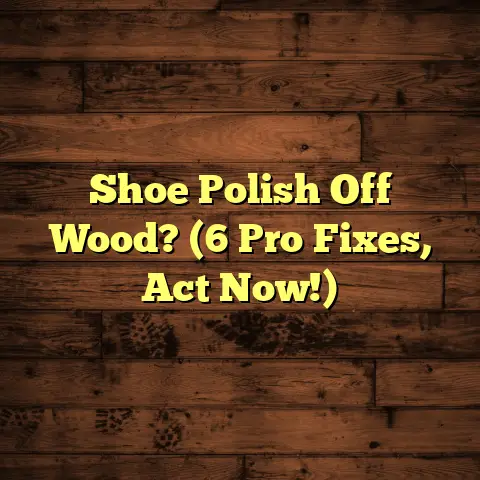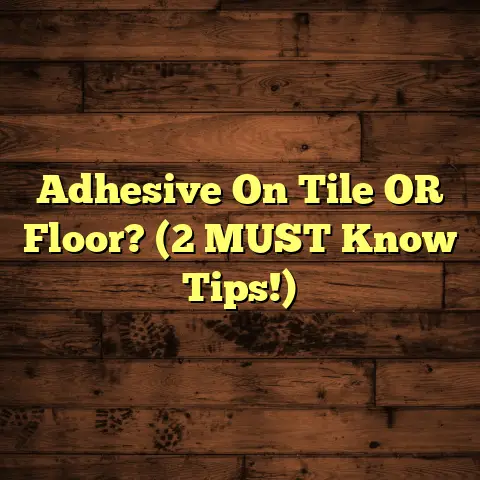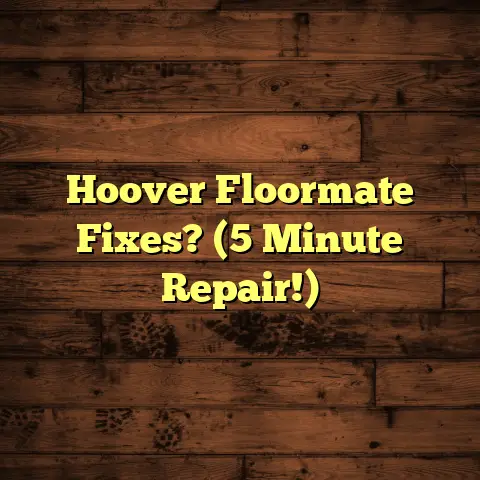Utility Trailer Floor Board Replacement? (4 Tools!)
Think about your utility trailer.
It’s a workhorse,
right?
Hauling everything from landscaping supplies
to that vintage motorcycle you just scored.
Its floorboards are designed to take a beating, but here’s the thing: that very durability can lead to us overlooking their slow decline.
It’s a paradox!
We expect them to last forever,
but the constant pressure from loads, rain, snow,
and good old wear and tear eventually takes its toll.
Ignoring those worn floorboards is like ignoring
a cavity – it only gets worse.
Damaged floorboards
can compromise the whole trailer, leading to
safety hazards and costly repairs down the road.
That’s why I’m here to guide you through replacing
your utility trailer’s floorboards using just four
essential tools.
Trust me, it’s a project you can
tackle yourself with a little know-how.
Let’s get started!
Section 1: Understanding the Importance of
Floorboards in Utility Trailers
1.1 The Role of Floorboards in Structural Integrity
Ever wonder why those floorboards are so important?
They’re not just there to give you a place to set
your cargo.
They’re a key part of the trailer’s
structural integrity.
Think of the trailer frame as the skeleton, and the
floorboards as the muscles and ligaments holding
it all together.
The floorboards distribute the
load across the frame, preventing stress and
potential bending or warping.
According to the National Association of Trailer
Manufacturers (NATM), proper floorboard installation
and maintenance are crucial for maintaining the
trailer’s weight capacity and ensuring safe operation.
(Source: NATM Guidelines for Trailer Maintenance).
When floorboards are damaged, that load distribution
is compromised.
You’re putting extra stress on the
frame, which can lead to cracks, bends, and even
complete failure.
Imagine hitting a pothole with a heavily loaded
trailer and weakened floorboards – not a pretty
picture, right?
It can cause the load to shift,
making the trailer unstable and potentially
causing an accident.
Beyond safety, damaged floorboards can shorten the
life of your trailer.
A weakened frame is more
susceptible to rust and corrosion, leading to
expensive repairs or even the need to replace the
entire trailer.
1.2 Common Signs of Floorboard Damage
Okay, so how do you know if your floorboards are
on their way out?
Here are some telltale signs:
Warping: Are the boards starting to bow up
or sag in the middle?
That’s a sign of moisture
damage or excessive weight.-
Cracking: Small cracks might seem harmless,
but they can quickly spread and weaken the
board’s structure. Soft Spots: This is a big one.
If you step
on a board and it feels spongy or gives way,
that’s a sign of rot and serious damage.-
Splintering: Boards that are constantly exposed
to the elements can start to splinter, creating
sharp edges and weakening the wood. -
Discoloration: Dark stains or discoloration
can indicate moisture damage and rot.
How to Inspect Your Trailer Floor:
Visual Check: Start by visually inspecting
the entire floor.
Look for any of the signs
mentioned above.The “Poke Test”: Use a screwdriver or
awl to gently poke at suspicious areas.
If
the wood is soft and easily penetrated, it’s
likely rotten.-
Bounce Test: Walk across the floor and
pay attention to any areas that feel spongy
or weak. Underneath Inspection: Get under the trailer
and inspect the floorboards from below.
Look
for signs of rot, damage, or loose fasteners.
This is where you’ll often see the worst of
the damage.
Pro Tip: I recommend inspecting your trailer
floor at least twice a year, especially before
and after heavy use.
This will help you catch
problems early and prevent them from escalating.
Section 2: Preparing for the Replacement Process
2.1 Assessing the Extent of Damage
Alright, you’ve inspected your floorboards and
found some damage.
Now what?
The first step is
to figure out whether you need a partial or full
replacement.
Partial Replacement: If the damage is limited
to a few boards, you might be able to get away
with replacing just those sections.
This is
a good option if the rest of the floor is in
relatively good condition.-
Full Replacement: If the damage is widespread,
or if the existing boards are old and brittle,
a full replacement is usually the best option.
This will give you a fresh start and ensure
the long-term integrity of your trailer.
Here’s how to decide:
-
Percentage of Damage: If more than 25% of
the boards are damaged, a full replacement is
probably the way to go. -
Age of the Boards: If the boards are more
than 10 years old, they may be nearing the end
of their lifespan, regardless of the visible
damage. -
Type of Damage: Extensive rot or structural
damage usually calls for a full replacement.
My Recommendation: When in doubt, go for a
full replacement.
It’s more work upfront, but
it will save you headaches (and potentially
money) in the long run.
2.2 Gathering Materials and Tools
Okay, you’ve decided to replace your floorboards.
Now it’s time to gather your materials and tools.
Here’s what you’ll need:
New Floorboards: Choose pressure-treated
lumber that’s rated for outdoor use.
The
thickness of the boards will depend on the
trailer’s weight capacity, but 2×6 or 2×8
boards are common.Fasteners: Use galvanized or stainless-steel
screws or bolts to attach the new boards to
the frame.
Avoid using nails, as they can
loosen over time.-
Wood Preservative: Apply a wood preservative
to the new boards to protect them from moisture
and rot. -
Safety Glasses: Protect your eyes from flying
debris. -
Work Gloves: Protect your hands from splinters
and sharp edges. -
Pencil and Paper: For taking measurements
and making notes.
And now, for the four essential tools:
Tool 1: Circular Saw
A circular saw is essential for making precise cuts
on your new floorboards.
You’ll need it to cut the
boards to the correct length and width, and to make
any necessary notches or angles.
Why a Circular Saw?
-
Speed and Efficiency: Circular saws are much
faster and more efficient than hand saws,
especially when cutting thick lumber. -
Precision: With a good blade and a steady
hand, you can make very accurate cuts. -
Versatility: Circular saws can be used to cut
a variety of materials, not just wood.
My Tip: Invest in a good quality circular saw
with a sharp blade.
A dull blade will make it
harder to cut accurately and can even be dangerous.
I prefer a carbide-tipped blade for cutting
pressure-treated lumber.
Tool 2: Pry Bar
A pry bar is your best friend when it comes to
removing old floorboards.
It allows you to lift
the boards without damaging the trailer frame.
Why a Pry Bar?
-
Leverage: A pry bar provides the leverage
you need to lift stubborn boards. -
Minimal Damage: When used carefully, a pry
bar can remove boards without causing excessive
damage to the frame. -
Versatility: A pry bar can also be used to
remove stubborn fasteners or to separate boards
that are stuck together.
My Tip: Use a wide, flat pry bar to minimize
the risk of damaging the frame.
Work slowly and
carefully, and don’t force anything.
If a board
is particularly stubborn, try using a hammer to
gently tap the pry bar underneath it.
Tool 3: Drill and Drill Bits
A drill is essential for attaching the new floorboards
to the trailer frame.
You’ll need it to pre-drill
holes for the screws or bolts, which will prevent
the wood from splitting.
Why a Drill?
-
Speed and Efficiency: A drill is much faster
and more efficient than driving screws or bolts
by hand. -
Precision: A drill allows you to create
accurate holes for the fasteners. -
Versatility: A drill can be used for a variety
of tasks, such as driving screws, drilling holes,
and even sanding.
My Tip: Use a drill bit that’s slightly smaller
than the diameter of the screws or bolts you’re
using.
This will ensure a snug fit.
I also
recommend using a countersink bit to create a
recess for the screw heads, which will prevent
them from protruding above the surface of the board.
Tool 4: Measuring Tape
Accurate measurements are crucial for a proper fit.
A measuring tape will help you determine the length
and width of the new floorboards, as well as the
spacing between the frame members.
Why a Measuring Tape?
-
Accuracy: A measuring tape provides accurate
measurements, which are essential for a
professional-looking job. -
Consistency: A measuring tape allows you to
take consistent measurements, which will ensure
that all of the floorboards are the same size. -
Versatility: A measuring tape can be used for
a variety of tasks, such as measuring lumber,
determining the spacing between objects, and
even laying out a room.
My Tip: Use a metal measuring tape that’s at
least 25 feet long.
This will give you enough
reach to measure even the largest trailers.
I also
recommend using a pencil to mark your measurements
on the lumber.
Section 3: Step-by-Step Replacement Process
3.1 Removing the Old Floorboards
Alright, let’s get down to business! Here’s how to remove the old floorboards:
-
Safety First: Put on your safety glasses
and work gloves. Remove Fasteners: Use a drill or screwdriver
to remove any screws or bolts that are holding
the floorboards in place.
If the fasteners are
rusted or stripped, you may need to use a
penetrating oil or a bolt extractor.Pry Up the Boards: Insert the pry bar
underneath the edge of a floorboard and gently
lift.
Work your way along the board, prying it
up a little at a time.Cut Stubborn Boards: If a board is particularly
stubborn, you may need to use the circular saw
to cut it into smaller sections.
This will make
it easier to pry up.Dispose of Old Boards: Dispose of the old
floorboards properly.
Pressure-treated lumber
should not be burned.
My Tip: Be careful when prying up the boards,
as you don’t want to damage the trailer frame.
Work slowly and carefully, and don’t force anything.
3.2 Preparing the Trailer Frame
Once you’ve removed the old floorboards, it’s time to prepare the trailer frame for the new ones.
-
Clean the Frame: Use a wire brush to remove
any rust, dirt, or debris from the frame. -
Inspect for Damage: Carefully inspect the
frame for any signs of cracks, bends, or rust. -
Repair Damage: If you find any damage,
repair it before installing the new floorboards.
Small cracks can be welded, and rusted areas
can be treated with a rust converter. -
Apply a Protective Coating: Apply a coat
of rust-resistant paint or primer to the frame
to protect it from corrosion.
My Tip: Pay close attention to the areas where
the floorboards attach to the frame.
These areas
are particularly susceptible to rust and damage.
3.3 Measuring and Cutting New Floorboards
Now it’s time to measure and cut the new floorboards.
-
Measure the Frame: Use the measuring tape
to measure the length and width of the trailer
frame. Cut the Boards: Use the circular saw to cut
the new floorboards to the correct length and
width.
Be sure to cut the boards slightly
longer than needed, as you can always trim
them down later.Test Fit: Place the new floorboards on the
frame to test the fit.
If necessary, trim the
boards to ensure a snug fit.-
Cut Notches: If the floorboards need to fit
around any obstacles, such as wheel wells or
tie-down points, use the circular saw to cut
notches in the boards.
My Tip: Take your time and measure carefully.
It’s better to cut the boards too long than too
short.
You can always trim them down later, but
you can’t add wood back on.
3.4 Installing the New Floorboards
Alright, the moment of truth! Here’s how to install the new floorboards:
-
Apply Wood Preservative: Apply a wood
preservative to the new floorboards to protect
them from moisture and rot. -
Position the Boards: Place the new floorboards
on the frame, making sure they are properly
aligned. -
Pre-Drill Holes: Use the drill to pre-drill
holes through the floorboards and into the
frame. -
Attach the Boards: Use galvanized or
stainless-steel screws or bolts to attach the
floorboards to the frame. -
Tighten Fasteners: Tighten the fasteners
securely, but don’t overtighten them, as this
can strip the threads or damage the wood.
My Tip: Use a consistent pattern when attaching
the floorboards to the frame.
This will help to
distribute the load evenly.
I recommend using at
least two fasteners per board at each frame member.
Section 4: Finishing Touches and Maintenance Tips
4.1 Sealing and Protecting the New Floorboards
Once you’ve installed the new floorboards, it’s important to seal and protect them from the elements.
-
Clean the Boards: Use a broom or brush to
remove any dirt or debris from the boards. Apply a Sealer: Apply a high-quality wood
sealer to the boards.
This will help to protect
them from moisture, UV rays, and wear and tear.
I recommend using a sealant that’s specifically
designed for outdoor use.Apply a Topcoat: For added protection, you
can apply a topcoat of paint or stain to the
boards.
This will also give them a more
finished look.
My Tip: Choose a sealant and topcoat that are
compatible with pressure-treated lumber.
Some
sealants can react with the chemicals in the wood,
causing them to break down prematurely.
4.2 Routine Maintenance to Extend Floorboard Life
To keep your floorboards in good condition, it’s important to perform routine maintenance.
-
Regular Inspections: Inspect the floorboards
at least twice a year for signs of damage,
such as cracks, rot, or loose fasteners. -
Clean Regularly: Clean the floorboards regularly
with a broom or brush to remove dirt and debris. -
Apply Sealant: Reapply sealant every year or
two to protect the boards from the elements. -
Avoid Overloading: Avoid overloading the
trailer, as this can put excessive stress on
the floorboards. -
Store Properly: When not in use, store the
trailer in a covered area to protect it from
the elements.
My Tip: Pay attention to the areas where the
floorboards are most likely to get damaged, such
as the edges and corners.
These areas are more
susceptible to moisture and wear and tear.
Conclusion: The Paradox Resolved
So, we’ve come full circle.
We started with the
paradox of durable floorboards that eventually
deteriorate, and we’ve ended with a solution:
knowledge, action, and a little elbow grease.
By understanding the importance of floorboards, knowing how to identify damage, and following the steps outlined in this article, you’ve empowered yourself to tackle this essential maintenance task.
A well-maintained trailer is a safe trailer, and
a safe trailer is a valuable asset.
By taking care
of your floorboards, you’re not only protecting
your cargo but also extending the life of your
investment.
With the right tools, techniques, and a little persistence, you can ensure that your utility trailer remains a reliable companion for all your hauling needs.
Now get out there and show those floorboards who’s boss!
And as always, happy hauling!





